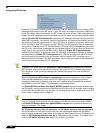
VoIP
519
SonicOS Enhanced 4.0 Administrator Guide
Figure 47:2 Local VoIP Call Flow
The following describes the sequence of events shown in Figure 42.2:
1. Phones A and B register with VoIP server - The SonicWALL security appliance builds a
database of the accessible IP phones behind it by monitoring the outgoing VoIP registration
requests. SonicOS translates between the phones’ private IP addresses and the firewall’s
public IP address. The VoIP server is unaware that the phones are behind a firewall. It
associates the same IP address for both phones, but different port numbers.
2. Phone A initiates a call to phone B by sending a request to the VoIP server - Even
though they are behind the same firewall, phone A does not know Phone B’s IP address.
Phone A initiates a call to phone B using a phone number or alias.
3. VoIP Server validates the call request and sends the request to phone B - The VoIP
server sends the call request to the firewall’s public IP address.The firewall then determines
phone B’s private IP address.
4. Phone B rings and is answered - When phone B is answered, the firewall translate its
private IP information to use the firewall’s public IP address for messages to the VoIP
server.
5. VoIP Server returns phone B media IP information to phone A - Both the called and
calling party information within the messages are translated by SonicOS back to the private
addresses and ports for phone A and phone B.
6. Phone A and phone B directly exchange audio/video/data - The SonicWALL security
appliance routes traffic directly between the two phones over the LAN. Directly connecting
the two phones reduces the bandwidth requirements for transmitting data to the VoIP server
and eliminates the need for the SonicWALL security appliance to perform address
translation.


















